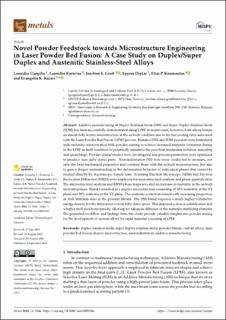| dc.contributor.author | Gargalis, Leonidas | |
| dc.contributor.author | Karavias, Leonidas | |
| dc.contributor.author | Graff, Joachim Seland | |
| dc.contributor.author | Diplas, Spyridon | |
| dc.contributor.author | Koumoulos, Elias P. | |
| dc.contributor.author | Karaxi, Evangelia K. | |
| dc.date.accessioned | 2024-04-11T12:47:06Z | |
| dc.date.available | 2024-04-11T12:47:06Z | |
| dc.date.created | 2023-11-07T12:33:19Z | |
| dc.date.issued | 2023 | |
| dc.identifier.citation | Metals. 2023, 13 (9): 1546 . | en_US |
| dc.identifier.issn | 2075-4701 | |
| dc.identifier.uri | https://hdl.handle.net/11250/3126135 | |
| dc.description.abstract | Additive manufacturing of Duplex Stainless Steels (DSS) and Super Duplex Stainless Steels (SDSS) has been successfully demonstrated using LPBF in recent years, however, both alloys feature an almost fully ferritic microstructure in the as-built condition due to the fast cooling rates associated with the Laser Powder Bed Fusion (LPBF) process. Blends of DSS and SDSS powders were formulated with austenitic stainless-steel 316L powder, aiming to achieve increased austenite formation during in the LPBF as-built condition to potentially minimize the post heat treatments (solution annealing and quenching). Powder characteristics were investigated and process parameters were optimized to produce near fully dense parts. Nanoindentation (NI) tests were conducted to measure, not only the local mechanical properties and correlate them with the as-built microstructure, but also to gain a deeper understanding in the deformation behavior of individual phases that cannot be studied directly by macroscopic tensile tests. Scanning Electron Microscopy (SEM) and Electron Backscatter Diffraction (EBSD) were employed for microstructural analysis and phase quantification. The microstructural analysis and EBSD phase maps revealed an increase in austenite in the as-built microstructures. Blend 1 resulted in a duplex microstructure consisting of 10% austenite at the XY plane and 20% austenite at the XZ plane. The austenite content increased with increasing proportion of 316L stainless steel in the powder blends. The DSS blend required a much higher volumetric energy density for the fabrication of near fully dense parts. This imposed a slower solidification and a higher melt pool homogeneity, allowing for adequate diffusion of the austenite stabilizing elements. The presented workflow and findings from this study provide valuable insights into powder mixing for the development of custom alloys for rapid material screening in LPBF. | en_US |
| dc.language.iso | eng | en_US |
| dc.publisher | MDPI | en_US |
| dc.rights | Navngivelse 4.0 Internasjonal | * |
| dc.rights.uri | http://creativecommons.org/licenses/by/4.0/deed.no | * |
| dc.title | Novel Powder Feedstock towards Microstructure Engineering in Laser Powder Bed Fusion: A Case Study on Duplex/Super Duplex and Austenitic Stainless-Steel Alloys | en_US |
| dc.title.alternative | Novel Powder Feedstock towards Microstructure Engineering in Laser Powder Bed Fusion: A Case Study on Duplex/Super Duplex and Austenitic Stainless-Steel Alloys | en_US |
| dc.type | Peer reviewed | en_US |
| dc.type | Journal article | en_US |
| dc.description.version | publishedVersion | en_US |
| dc.rights.holder | © 2023 by the authors. Published by MDPI. | en_US |
| dc.source.pagenumber | 24 | en_US |
| dc.source.volume | 13 | en_US |
| dc.source.journal | Metals | en_US |
| dc.source.issue | 9 | en_US |
| dc.identifier.doi | 10.3390/met13091546 | |
| dc.identifier.cristin | 2193233 | |
| dc.relation.project | EC/H2020/952869 | en_US |
| dc.source.articlenumber | 2193233 | en_US |
| cristin.ispublished | true | |
| cristin.fulltext | original | |
| cristin.qualitycode | 1 | |

